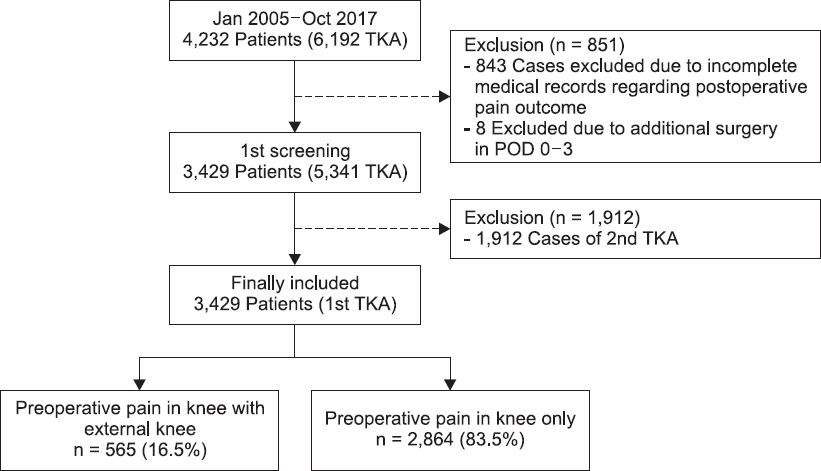1. Maradit Kremers H, Larson DR, Crowson CS, Kremers WK, Washington RE, Steiner CA, et al. Prevalence of total hip and knee replacement in the United States. J Bone Joint Surg Am. 2015; 97:1386–97. DOI:
10.2106/JBJS.N.01141. PMID:
26333733. PMCID:
PMC4551172.
2. Brander V, Stulberg SD. Rehabilitation after hipand knee-joint replacement An experienceand evidence-based approach to care. Am J Phys Med Rehabil. 2006; 85(11 Suppl):98–118. quiz S119-23. DOI:
10.1097/01.phm.0000245569.70723.9d. PMID:
17079984.
3. Beswick AD, Wylde V, Gooberman-Hill R, Blom A, Dieppe P. What proportion of patients report long-term pain after total hip or knee replacement for osteoarthritis?A systematic review of prospective studies in unselected patients. BMJ Open. 2012; 2:e000435. DOI:
10.1136/bmjopen-2011-000435. PMID:
22357571. PMCID:
PMC3289991.
4. Puolakka PA, Rorarius MG, Roviola M, Puolakka TJ, Nordhausen K, Lindgren L. Persistent pain following knee arthroplasty. Eur J Anaesthesiol. 2010; 27:455–60. DOI:
10.1097/EJA.0b013e328335b31c. PMID:
20299989.
5. Teichtahl AJ, Wluka AE, Proietto J, Cicuttini FM. Obesity and the female sex, risk factors for knee osteoarthritis that may be attributable to systemic or local leptin biosynthesis and its cellular effects. Med Hypotheses. 2005; 65:312–5. DOI:
10.1016/j.mehy.2005.02.026. PMID:
15922106.
6. Imamura M, Imamura ST, Kaziyama HH, Targino RA, Hsing WT, de Souza LP, et al. Impact of nervous system hyperalgesia on pain, disability, and quality of life in patients with knee osteoarthritis:a controlled analysis. Arthritis Rheum. 2008; 59:1424–31. DOI:
10.1002/art.24120. PMID:
18821657.
7. Lee YC, Lu B, Bathon JM, Haythornthwaite JA, Smith MT, Page GG, et al. Pain sensitivity and pain reactivity in osteoarthritis. Arthritis Care Res (Hoboken). 2011; 63:320–7. DOI:
10.1002/acr.20373. PMID:
20957660. PMCID:
PMC3030930.
8. Schaible HG. Spinal mechanisms contributing to joint pain. No-vartis Found Symp. 2004; 260:4–22. discussion 22-7, 100-4, 277-9. PMID:
15283441.
9. Nie H, Graven-Nielsen T, Arendt-Nielsen L. Spatial and temporal summation of pain evoked by mechanical pressure stimulation. Eur J Pain. 2009; 13:592–9. DOI:
10.1016/j.ejpain.2008.07.013. PMID:
18926745.
10. Staud R, Koo E, Robinson ME, Price DD. Spatial summation of mechanically evoked muscle pain and painful aftersensations in normal subjects and fibromyalgia patients. Pain. 2007; 130:177–87. DOI:
10.1016/j.pain.2007.03.015. PMID:
17459587. PMCID:
PMC2041939.
11. Kim MH, Nahm FS, Kim TK, Chang MJ, Do SH. Comparison of postoperative pain in the first and second knee in staged bilateral total knee arthroplasty:clinical evidence of enhanced pain sensitivity after surgical injury. Pain. 2014; 155:22–7. DOI:
10.1016/j.pain.2013.08.027. PMID:
23994101.
12. D'Hoore W, Sicotte C, Tilquin C. Risk adjustment in outcome assessment:the Charlson comorbidity index. Methods Inf Med. 1993; 32:382–7. DOI:
10.1055/s-0038-1634956. PMID:
8295545.
14. Lluch E, Torres R, Nijs J, Van Oosterwijck J. Evidence for central sensitization in patients with osteoarthritis pain:a systematic literature review. Eur J Pain. 2014; 18:1367–75. DOI:
10.1002/j.1532-2149.2014.499.x. PMID:
24700605.
15. Fingleton C, Smart K, Moloney N, Fullen BM, Doody C. Pain sensitization in people with knee osteoarthritis:a systematic review and meta-analysis. Osteoarthritis Cartilage. 2015; 23:1043–56. DOI:
10.1016/j.joca.2015.02.163. PMID:
25749012.
16. Rakel BA, Blodgett NP, Bridget Zimmerman M, Logsden-Sackett N, Clark C, Noiseux N, et al. Predictors of postoperative movement and resting pain following total knee replacement. Pain. 2012; 153:2192–203. DOI:
10.1016/j.pain.2012.06.021. PMID:
22840570. PMCID:
PMC3472094.
17. Staud R, Vierck CJ, Cannon RL, Mauderli AP, Price DD. Abnormal sensitization and temporal summation of second pain (wind-up) in patients with fibromyalgia syndrome. Pain. 2001; 91:165–75. DOI:
10.1016/S0304-3959(00)00432-2. PMID:
11240089.
18. Staud R. Abnormal endogenous pain modulation is a shared characteristic of many chronic pain conditions. Expert Rev Neurother. 2012; 12:577–85. DOI:
10.1586/ern.12.41. PMID:
22550986. PMCID:
PMC3373184.
19. Julien N, Goffaux P, Arsenault P, Marchand S. Widespread pain in fibromyalgia is related to a deficit of endogenous pain inhibition. Pain. 2005; 114:295–302. DOI:
10.1016/j.pain.2004.12.032. PMID:
15733656.
21. Graven-Nielsen T, Wodehouse T, Langford RM, Arendt-Nielsen L, Kidd BL. Normalization of widespread hyperesthesia and facilitated spatial summation of deep-tissue pain in knee osteoarthritis patients after knee replacement. Arthritis Rheum. 2012; 64:2907–16. DOI:
10.1002/art.34466. PMID:
22421811.
22. Lluch Girbés E, Dueñas L, Barbero M, Falla D, Baert IA, Meeus M, et al. Expanded distribution of pain as a sign of central sensitization in individuals with symptomatic knee osteoarthritis. Phys Ther. 2016; 96:1196–207. DOI:
10.2522/ptj.20150492. PMID:
26939604.
23. Wylde V, Sayers A, Lenguerrand E, Gooberman-Hill R, Pyke M, Beswick AD, et al. Preoperative widespread pain sensitization and chronic pain after hip and knee replacement:a cohort analysis. Pain. 2015; 156:47–54. DOI:
10.1016/j.pain.0000000000000002. PMID:
25599300. PMCID:
PMC4280282.
24. Wylde V, Sayers A, Odutola A, Gooberman-Hill R, Dieppe P, Blom AW. Central sensitization as a determinant of patients'benefit from total hip and knee replacement. Eur J Pain. 2017; 21:357–65. DOI:
10.1002/ejp.929. PMID:
27558412. PMCID:
PMC5245112.
25. Han T. Opioids in cancer and non-cancer pain management in Korea:the past, present and future. Eur J Pain. 2001; 5(Suppl A):73–8. DOI:
10.1053/eujp.2001.0284. PMID:
11798222.
26. Kim KY, Anoushiravani AA, Chen KK, Roof M, Long WJ, Schwarzkopf R. Preoperative chronic opioid users in total knee arthroplasty-which patients persistently abuse opiates following surgery? J Arthroplasty. 2018; 33:107–12. DOI:
10.1016/j.arth.2017.07.041. PMID:
28844770.
27. Armaghani SJ, Lee DS, Bible JE, Archer KR, Shau DN, Kay H, et al. Preoperative opioid use and its association with perioperative opioid demand and postoperative opioid independence in patients undergoing spine surgery. Spine (Phila Pa 1976). 2014; 39:E1524–30. DOI:
10.1097/BRS.0000000000000622. PMID:
25417827.




 PDF
PDF Citation
Citation Print
Print




 XML Download
XML Download